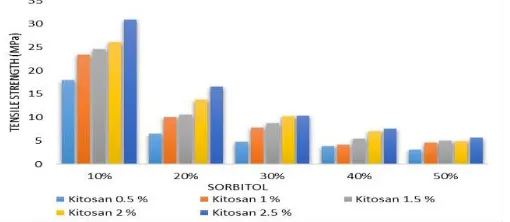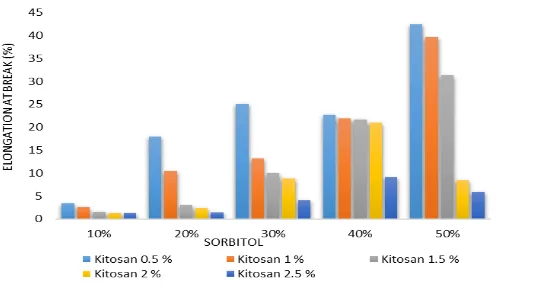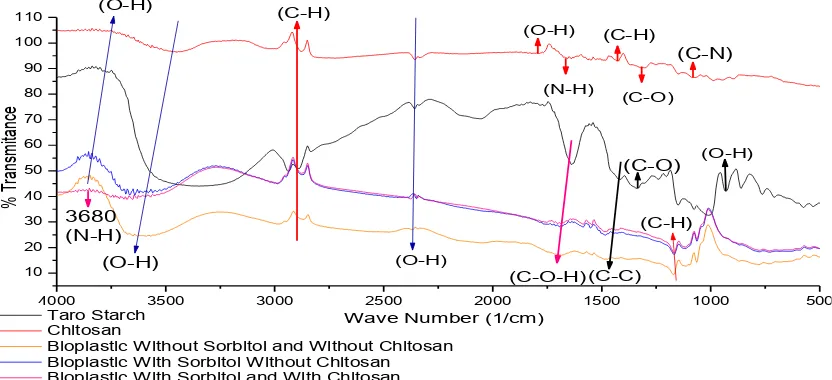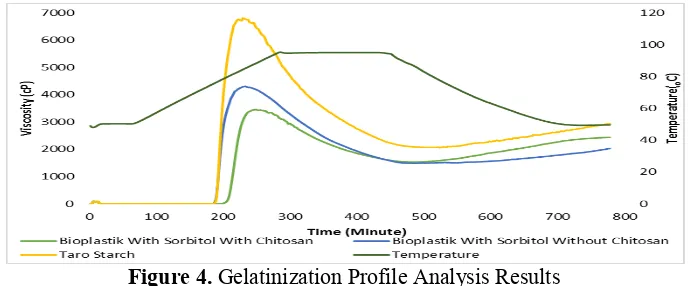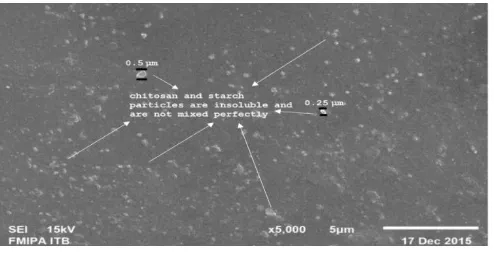The effect of increasing chitosan on the characteristics of
bioplastic from starch talas (Colocasia esculenta) using
plasticizer sorbitol
M H S Ginting1, M Lubis1, T Sidabutar1, and T P Sirait1 1
Department of Chemical Engineering, Universitas Sumatera Utara, Jalan Almamater, Medan, 20155, Indonesia
E-mail: hendra.ginting@usu.ac.id
Abstract. The aims of this research to determine the profile of starch gelatinization, bioplastic and the effect of increasing chitosan and sorbitol to the properties of tensile strength and elongation of break bioplastic. Preparation of bioplastics was used by casting method, that is 30% w/v solution of starch mixed with chitosan solution (0.5 w/v ; 1 w/v; 1.5 w/v; 2 w/v; and 2.5 w/v) and plasticizer sorbitol (10 % w/w; 20 % w/w; 30 % w/w; 40 % w/w and 50 % w/w) were heated using a hotplate magnetic stirrer at 750C. The results of Rapid Visco Analyzer (RVA) obtained by starch and bioplastic gelatinization temperature of 72.94°C; 77.72°C with peak viscosity 6632 cP and 3476 cP. Analysis of Fourier Transform Infrared (FTIR) and Scanning Electron Microscopy (SEM) obtained the change a functional group of bioplastic O-H at wave number 3765 cm-1 and uneven chitosan distribution, and there is still an empty fraction. The addition of chitosan and sorbitol had an effect on tensile strength and elongation at break, tensile strength and elongation at break the highest of 8.36 MPa and 22.06% in starch composition 30%, 2.5 w/v chitosan and sorbitol 30% w/w.
1. Introduction
Bioplastic is plastics made from renewable resources (starch) and biodegradable [1]. Starch is a form of energy storage produced by all green plants. Starch-based bioplastic research has done, using potato starch, sago, maize, taro, cassava stem starch, avocado seeds and durian seeds [2, 3, 4, 5, 6, 7, 8]. The taro starch to be material bioplastic because it contains high starch [9]. Starch bioplastics have weaknesses, among others like hydrophilic, less hydrophobic and low mechanical properties, so it’s necessary to add cellulose filler, chitosan (0.37-1.45%) [7, 10], to fixed the elasticity properties must added glycerol plasticizer (10%-40%) or sorbitol 30% [3, 11]. The purpose of this research was to determine the profile of starch gelatinization, the effect of adding chitosan and sorbitol to the properties of tensile strength, elongation at break, functional groups and surface morphology of bioplastics.
2. Material and Method
2.1 Materials
2.2 Isolation Taro Starch Procedure
Taro is cut thin [12] with a thickness of ± 2 mm [13], repeatedly rinsed with water until clean and dried under the sun for 6 hours. Dry taro is blended by adding 1: 5 (w / v) water to form a slurry. The slurry of taro starch is taken by the filtrate (starch suspension). Suspension of starch is precipitated for 24-48 hours. The wet starch was dried in an oven at 50°C [8] for ± 24 hours until dry [14]. The dried starch is milled and sieved to be a size of 100 mesh [11].
2.3 Manufacture Bioplastic
Into the beaker glass is inserted 0.5% w chitosan and 100 ml of 2% acetic acid stirred until homogeneous. The taro starch 20% w/ml, acetic acid 2 ml and sorbitol solution 20% w and heated using hotplate magnetic stirrer at 75°C for 30 minutes at 375 rpm to homogeneous. The bioplastic solution poured onto acrylic plate mold 25 cm x 25 cm x 1cm and dried the oven at 45oC for 24 hours. After drying into the desiccator for 24 hours [7].
2.4 Characteristics of Bioplastic
2.4.1 Analysis of Mechanical Characteristics.
Measurement test of tensile strength and elongation at break is done based on the ASTM D882.
2.4.2 Analysis of gelatinization profile
Analysis of gelatinization profile is done using Rapid Visco Analyzer (RVA) and carried out in Laboratory of Industrial Technology of Agriculture Faculty, University of Padjadjaran, Bandung.
2.4.3 Analysis of Fourier Transform Infra Red (FTIR)
Fourier Transform Infra Red (FTIR) analysis was doing at Laboratory of the Faculty of Pharmacy University of Sumatera Utara, Medan.
2.4.4 Analysis of Scanning Electron Microscopy (SEM)
Scanning Electron Microscopy (SEM) analysis was doing at Laboratory Faculty of Mathematics and Natural Sciences Institute Teknologi of Bandung (ITB).
3. Results and Discussion
3.1 Tensile Strength
The effect of adding chitosan and sorbitol to the properties of tensile strength is presented by figure 1.
Figure 1. The effect of increasing chitosan and sorbitol to the properties of tensile strength
result from a physical interaction of hydrogen bonds between the starch and chitosan solution, so the resulting bioplastic had good tensile strength [7,11]. Figure 1 also showed added plasticizer sorbitol being decreasing the tensile strength, The smallest tensile strength 3.14 MPa in bioplastic with sorbitol plasticizer 50% composition and chitosan 0.5%. The decreasing of tensile strength disturbing compactness of bioplastic structure, thereby reducing the hydrogen bonding interaction (internal molecules) which causes the weakening of intermolecular forces of adjacent polymer chains. This decrease in tensile strength was in by Ginting et al. (2016) bioplastic research of durian seed starch with sorbitol plasticiser, The greater the sorbitol concentration will decrease the tensile strength [16].
3.2 Elongation at Break.
The effect of increasing chitosan and sorbitol to the elongation at break is presented by Figure 2.
Figure 2. The effect of increasing chitosan and sorbitol to the elongation properties at break
4000 3500 3000 2500 2000 1500 1000 500
Characterization FTIR of taro starch, chitosan, bioplastic without/with chitosan filler with sorbitol plasticizer is presented by figure 3.
Figure 3. Fourier Transform Infrared (FTIR)
The FTIR of taro starch obtained by O-H, C-H, C = O, C-O-H, C-O and C-O-C groups. The resulting functional groups have represented taro starch groups such as amylose, amylopectin and reducing glucose (C6H10O5)n [54]. Chitosan, (C6H9NO3)n is also called poly β (1,4) -2
amino-2-Deoxy-D-Glucopyranose composed of amino and hydroxy groups [23]. FTIR analysis showed that chitosan had the functional group of N-H, C-H, O-H, C=O, C-O-H, C-O and C-O-C. The group has representatives of the chitosan functional group and chemical structure similar to cellulose and lignin [20]. FTIR analysis showed wave number 3765,05 cm-1 showing OH group from strain of alcohol, at wave number 2935 cm-1 showing CH group of strain alkane, at Wave number 2056,17 cm-1 showing OH group of hydrogen bond strain, at wave number 1338,60 cm-1 showing COH group of strain CH3, and
at wave number 929,69 cm-1 showing OH group of strain starch molecule ring.
3.4 Gelatinization Profile Analysis
Figure 4. Gelatinization Profile Analysis Results
The temperature of gelatinization is the temperature at which the starch granules expand rapidly and irreversible [18]. From the analysis, the temperature of gelatinization of taro starch, bioplastic without/with chitosan filler and sorbitol plasticizer was in the temperature range of starch gelatinization, which is stated by Yamin, et al. (1997), it was 68-850C [19] each of 72,94; 74.88; and 77,72oC. From the analysis result showed that taro starch processing into bioplastic by using plasticizer sorbitol increase the temperature of bioplastic gelatinization that is from 72,94oC to 74,88oC, while addition of chitosan filler in bioplastic process also increase gelatinization temperature from 72,94o C to 77,72o C. This is by the research of Spies and Hoseney (1982) that the addition of organic compounds will increase the temperature of gelatinization [20].
The addition of organic compounds such as chitosan and sorbitol will lead the addition of hydrogen bonds so that the space between molecules of starch is limited, and decrease the enthalpy of the system so that more heat is required to reach the gelatinization temperature of starch [21].
From the analysis, taro starch, bioplastic without/with an addition of sorbitol plasticiser and chitosan addition will decrease the peak viscosity of the bioplastic produced with the peak viscosity value of 6632; 4290; and 3476 CP. This is the increase of gelatinization temperature which causes decreased bioplastic viscosity because the viscosity of the liquid is inversely proportional to the temperature. This is also by the statement of Hirashima et al. (2005) which states that the addition of acid to the starch gelatinization process will decrease the viscosity of the liquid because the acid will first hydrolyze the starch molecule before gelatinization takes place [22]. From the analysis it was found that taro starch, bioplastic without/with filler and plasticizer sorbitol had a hold viscosity value of 2122 each; 1509; 1645 cP. Chitosan bioplastic (1645 cP) has a higher hold viscosity than bioplastic without chitosan (1509 cP). This is because acetic acid dissolves chitosan first and makes starch molecules hydrolyzed slightly so that the hold viscosity is higher.
From the analysis, taro starch, bioplastic without/with an addition of sorbitol plasticizer and chitosan addition had the value of breakdown viscosity of 4510 each; 2781; 1831 CP. The addition of sorbitol plasticiser reduces the viscocity breakdown of 1729 CP, and the addition of chitosan filler will reduce the viscosity breakdown of 2679 CP in the resulting bioplastic product. From the analysis result, it’s found that taro starch, bioplastic without/with an addition of sorbitol plasticiser and an addition of chitosan had a final viscosity of 2910 CP each; 2082.5 CP; And 2439 CP. Bioplastic with chitosan filler (2439 CP) has higher final viscosity value than non-chitosan bioplastic (2082,5 CP). Similarly, with the hold viscosity parameter, this is an increase of gelatinization temperature resulting and causes the decrease the viscosity mixture [23]. From the analysis result, it’s found by taro starch, bioplastic without/with addition of sorbitol plasticiser and chitosan addition had 1024 CP viscosity setback value; 709,5 CP and 830 CP
3.5 Scanning Microscopy Electron analysis (SEM)
Figure 5. Scanning Electron Microscopy (SEM)
The characterization of SEM morphological analysis results in the fracture area of tensile strength analysis with 5000x enlargement. From the picture is seen fracture analysis has a rigid structure and brittle structure which shows that the spread of chitosan particles is uneven and there is an empty fraction therein. The emergence of chitosan particles on the results of morphology analysis, caused chitosan is not dissolved by the solvent acetic acid 2%, while the appearance of voids on the morphology of bioplastics due to the air trapped when pouring process and alignment of bioplastics solution into a molding acrylic. The voids in bioplastics forming a gap or space that is affecting the bond between filler and matrix. The gap or space causes the middle to move to the void area so as to reduce the tensile strength value when the bioplastic is load. Insoluble chitosan particles will reduce of bioplastics tensile strength, Based on pasting analysis obtained the chitosan insoluble particles will reduce the hydroxyl that is interacting with amylose and amylopectin thus increasing the value of the elongation at break of bioplastics produced.
4. Conclusion
Based on this research gelatinization temperature of 72.94oC with peak viscosity of 6632 cP, best bioplastics obtained is on the composition of starch 30%, sorbitol 40% and chitosan 2% with a tensile strength of 7.05 MPa and elongation at break of 21.05%.
Acknowledgments
The authors gratefully acknowledge that the present research is supported by Ministry of Research and Technology and the Higher Education Republic of Indonesia. This research grant under of Fundamental Research Implementation of year 2014 (Batch II) Contract Number: 4806/UN5.1.R/ KEU/2014.
References
[1] Liu Z, Han J H 2005 Film Forming Characteristics of Starches. J. Food Science, 70 (1) E31-E36. [2] Borghei, Mehdi, Karbassi A, Oromiehie A, and Javid A 2010 Microbial biodegradable potato
starch based low density polyethylene. African Journal of Biotechnology. 9(26) 4075-4080. [3] Zuraida A, Yusliza Y, Anuar H and Muhaimin M H R 2012 The effect of water and citric acid on
sago starch bio-plastics. International Food Research Journal, 19(2) 715-719.
[4] Situmorang H, Ginting M H S 2014 Kajian Awal Pembuatan Film Plastik (Bahan Plastik Pengemas) dari Pati Batang Ubi Kayu Jurnal Teknik Kimia. 3(1) 27-31.
[5] Sinaga, R F, Ginting G M, Ginting M H S and Hasibuan R 2014 Pengaruh Penambahan Glisero
Terhadap Sifat Kekuatan Tarik dan Pemanjangan Saat Putus Bioplastik dari Pati Umbi Talas. Jurnal Teknik Kimia USU. 3(2)19-24.
[7] Ginting M H S, Hasibuan R, Lubis M, Tanjung D S and Iqbal N 2017 Effect of Hydrochlorid Acid Consentration as Chitosan Solvent on Mechanical Properties of Bioplastic from Durian Seed Starch (Durio Zhibethinus) with Filler Chitosan and Plasticizer Sorbitol. IOP Conf. Ser : Mater. Sci. Eng.180 012126 (http://iopscience.iop.org/1757-899X/180/1/012126.
[8] Cinelli P E, Chiellini, Lawton J W, Imam S H 2006 Foamed articles based on potato starch , corn fibers and poly ( vinyl alcohol) ” Polymer Degradation and Stability, 2006: 1147-1155. [9] Syamsir, Elvira, Talas 2012 Andalan Bogor, Institut Pertanian Bogor.
[10]Minh K, Yoksan R 2015 Development of thermoplastic starch blown film by incorporating plasticized chitosan.” Carbohydrate Polymers. 575-581.
[11]Lubis M, Harahap M B, Manulang A, Alfarodo, Ginting M H S and Sartika 2017 Utilazation Starch Jackfruit Seed (Artocarpus Heterophllus) as Raw Material for Bioplastic Manufacturing using Sorbitol as Plasticizer and Chitosan as Filler ” Journal of Physic Conforences Series : 80 012014 (http://iopscience.iop.org/1742-6596/801/1/0120141.
[12]Muaz A Z, Faiz M, Suffian M Y and Hamidi A A 2014 The Study of Flocculant Characteristics for Landfill Leachate Treatment Using Starch Based Flocculant from Durio Zibethinus Seed. Advances in Environmental Biology. 8(15) 129-135.
[13]Srianta, Hendrawan B, Kesumawati N and Blanc P J. 2012 Study on durian seed as a new substrate for angkak production.” International Food Research Journal. 941-945.
[14]Mirhosseini, Hamed, Nur Farhana, Rashid A, Tabatabaee B, Whye K and Kazemi M 2015 Effect of partial replacement of corn fl our with durian seed fl our and pumpkin fl our on cooking yield , texture properties , and sensory attributes of gluten free pasta.” LWT - Food Science and Technology. 63 184-190.
[15]Dallan, Paul Ruff Marreco 2006 Effects of Chitosan Solution Concentration and Incorporation of Chitin and Glycerol on Dense Chitosan Membrane Propertie. 394-405.
[16]Ginting M H S, Kristiani M, Amelia Y and Hasibuan R 2016 Effect of Chitosan, Sorbitol and Heating Temperature on Mechanical Properties of Bioplastic from Durian Seed Starch (Durio Zhibethinus), International Journal of Engineering Research and Applications. Vol 6, Issu I (part 5) January 2016, pp 33-38.
[17]Rodriguez, Maria, Javier O, Khalid Z, Mate J I 2006 Combined effect of plasticizers and surfactants on the physical properties of starch based edible films. 840-846.
[18]Michael S B 2011 Organic Chemistry: An acid-base approach, Boca Raton, USA, Taylor and Francis Group.
[19]Yamin F F, Svendsen L and White P J 1997 Thermal properties of corn starch extraction intermediates by differential scanning calorimetry. Cereal chemistry. 74(4), pp 407-411 [20]Spies R D dan Hoseney R C 1992 Effect of Sugar on Starch Gelatinization. American
Assossiation of Cereal Chemists Inc., Cereal Chem.59 (2), pp 128-131.
[21]Kohyama K, Nishinari K 1991 Effect of Soluble Sugars on Gelatinization and Retrogradation of Sweet Potato Starch. National Food Research Institute, Tsukuba, Ibaraki 305, Japan. J. Agric. Food Chem. 1001, 39, pp 1406-1410, 1991.
[22]Hirashima M, Takahashi R and Nishinari K 2005 Effects of adding acids before and after gelatinization on the viscoelasticity of cornstarch pastes. Department of Food and Human Health Sciences. Food Hydrocolloids Journal, vol. 19(5), pp 909-914.
